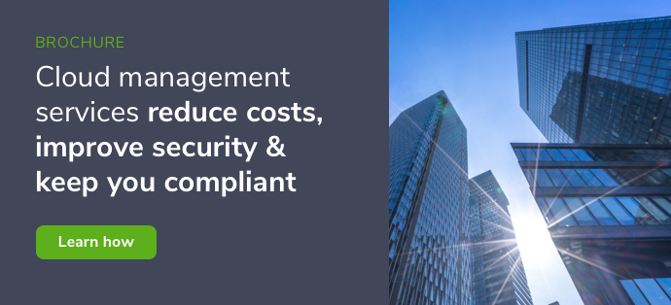Traditionally, IT has sat solely in the realm of the IT department, but now more and more employees are taking it into their own hands. In fact, 80% of workers admit to using SaaS applications at work without explicit approval from IT teams. And as organizations have had to quickly adapt to a newly remote workforce, this practice has only become more common.
From adopting cloud-based data storage to utilizing applications or software to fulfil day-to-day tasks – end-users and leadership alike have rapidly adopted cloud resources to keep their business connected and productive.
And the effects of the pandemic are likely to remain. Cloud is expected to make up 14.2% of the total global enterprise IT spending market by 2024, and dominate enterprise budgets in the future. However, rapid innovation also creates risks. Failing to optimize cloud processes as you continue to add to your cloud architecture can cause costly overhead to your business down the line. And this only becomes more detrimental without the ability to detect it.
What is Shadow IT?
The term shadow IT refers to solutions, systems, software, applications, or services that are used in your organization without your IT departments consent or awareness.
Shadow IT is a growing problem as end-users continue to become more IT-literate over time. Studies show that 41% of workers say that their general access to technologies has improved in the last year, highlighting an increase in IT understanding. Your internal teams can easily find and deploy SaaS applications or web-based file sharing within their department to enable better ways of working.
Shadow IT puts your IT department under more strain. You don’t want to stifle innovation in your business or pull the plug on internal teams finding the most efficient ways to work. But deploying new technology without effective monitoring creates inherent insufficiencies and security risks across your cloud infrastructure. Especially when your sensitive corporate data is uploaded to these solutions.
Additionally, enterprise budgets might be allocating more than what's needed towards a solution that has poor processes, or teams could still be paying for cloud services they don’t use.
How Shadow IT Puts Your Cloud at Risk
- Lack of monitoring
- No cost control
- Security of sensitive business data
- Cloud waste
- Inefficient processes
- Decreased visibility
How to Avoid Shadow IT
Your cloud environment supports the vital components of your business. From mission-critical processes to your customer data, you must understand what, how, why, and when cloud resources are being used – and leave no stone unturned.
To achieve this, enterprise organizations get support from a trusted cloud management provider. An expert team can audit your entire cloud infrastructure using powerful reporting, management, and optimization tools. This helps your business uncover full transparency over cloud resources and spend, reduce costs, and unlock long-term control over your cloud estate.
How can you regain control of your cloud environment and control the risk of shadow IT?
Audit Your Cloud Environment
A cloud audit will help your business immediately identify where cloud resources are being used incorrectly. Whether cloud spend has grown over time without internal teams realizing or you're overpaying for inefficient cloud vendors or services, an audit can provide a single view of your entire cloud estate. To instantly flag cloud-based shadow IT that appears in your network.
As part of an audit, your cloud management provider will provide helpful suggestions and opportunities to optimize the cloud environment. This will ensure that your cloud infrastructure is operating at maximum efficiency, without the unmonitored baggage of shadow IT.
Your accredited cloud management partner will work hand-in-hand with your business to implement cloud rightsizing to ensure that cloud resource demand is always in line with ideal resource supply. And through the audit process, your internal IT teams will gain better visibility of the cloud-based solutions that teams are using day-to-day, helping them regain control.
Boost Visibility of Cloud Assets
A cloud management provider can work as an extension of your IT department to regain control of your cloud inventory management. Enterprise organizations generate huge volumes of cloud resource information, but this is only useful when put into the right format.
With cloud management services, experts can create a resource tagging strategy for every cloud asset to enhance cloud management processes and visibility. They can work with you to to establish a tag policy and enforce it across all your CSP environments. Tag validity is ensured by real-time monitoring of current and newly added inventory, and your expert partner can retroactively normalize tags for ongoing reporting.
Additionally, as you gain better visibility of your cloud to reduce shadow IT, you also benefit from better cost controls. Cloud inventory management delivery can be integrated into your general ledger, helping eliminate time-consuming manual processes for internal IT staff. Improving cost visibility and highlighting cost saving opportunities.
Regain Control of Your Cloud
Achieving better visibility of your cloud estate is essential to reduce instances of shadow IT. However, in-house IT teams are already confined to the pressure of their day-to-day tasks, and managing IT support across your employees. Add to this the duty of optimizing cloud processes and the task naturally drops to the bottom of their to-do list.
This inefficiency is where shadow IT thrives. While your workforce utilize new cloud-based software, systems, and applications – your IT teams are none the wiser. But the risks of shadow IT should not halt innovation. With greater control your cloud estate, you'll reduce the threats of previously unmonitored cloud solutions.
A cloud management provider can help you monitor processes, identify cloud inefficiencies, and eliminate cloud waste. Your IT department will experience improved visibility of cloud resources and usage in your organization. And your chosen expert cloud-accredited partner will continuously handles reporting, management, and optimization processes for you.
To learn more about how to unlock long-term value from your cloud management, read our free brochure today and begin your journey to a secure cloud.


